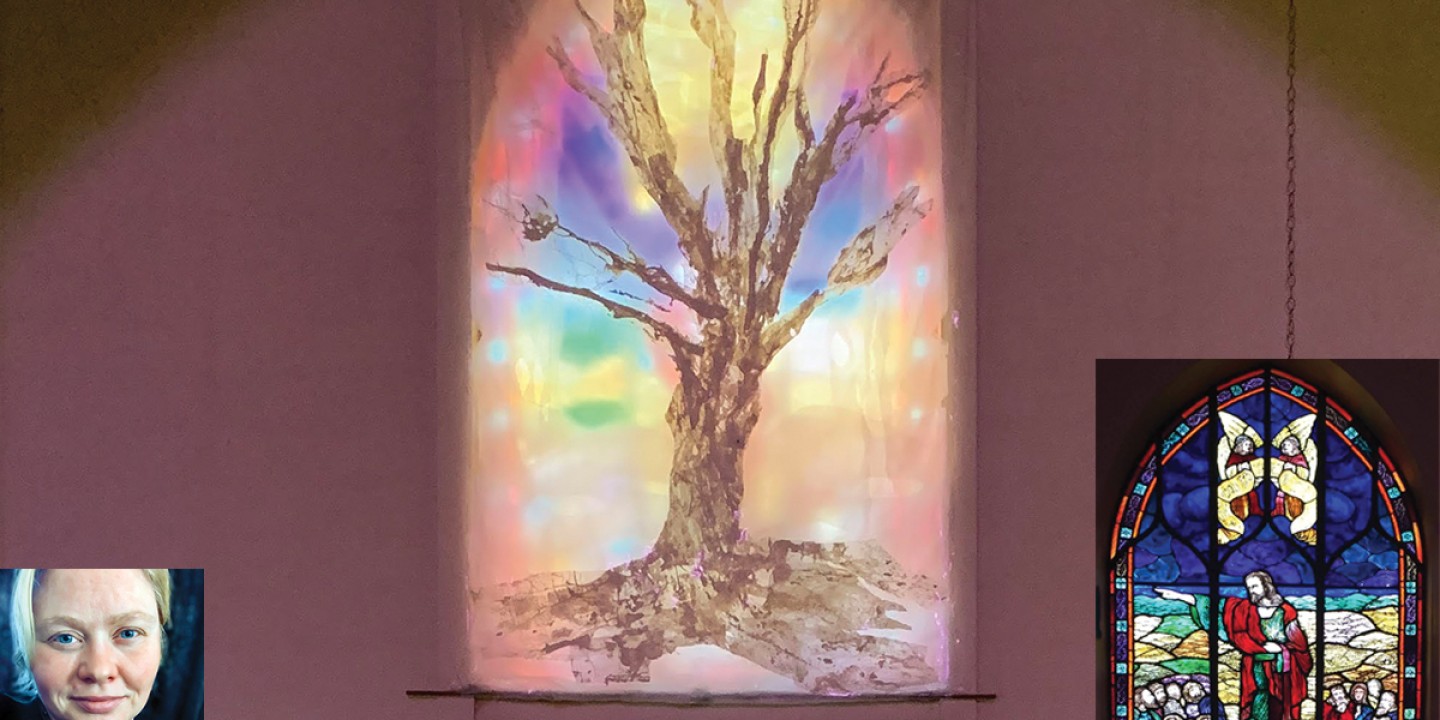This Seattle church’s stained-glass Jesus was far too White
So a local artist found a creative way to cover him up.

Darla DeFrance noticed the White man in the window the first time she walked into the church building. A friend who joined her on a tour of the space called him Manifest Destiny Jesus. He even points west.
The building was going to be the new home of Church of Hope, the Seattle congregation where DeFrance is pastor. But she “didn’t understand or relate to that image of Jesus,” she says. She was trying to build a community representative of the diverse neighborhood, and having one dominant image of God in the church “felt exclusive,” DeFrance says.
At the beginning of each service at Church of Hope, DeFrance asks where people saw God show up in the world that week. They sit in a circle so that everyone can see God reflected in one another. But that dominating image of White Jesus in the stained glass—in a sanctuary where not everyone is White—was “like wearing blinders,” she says. It made it hard to be more curious about who and what God could be.
Read our latest issue or browse back issues.
In September 2017, DeFrance began a sermon series on asking tough questions of God, and the mostly White congregation began to ask some tough questions of themselves. After Trump’s election and the uptick of racially motivated violence in US cities, they were beginning to wonder about their own roles in preserving White supremacy. For Church of Hope, this meant addressing the misleading image in the window and the normalization of Jesus as White.
Chasity Jones Selenga, who founded Fourth Wave Revolution to help decolonize social justice work, delivered a guest sermon at Church of Hope in which she pointed out that depicting Jesus as White isn’t just inaccurate, it “plagues the western hemisphere with its inaccuracy.” Such depictions can disconnect people of color from God. White people are not “the appropriate context” for all things divine, she said. As White Jesus looked down on her from the window, she asked: “Is it possible that we have created God in our image, not the other way around?” She went on to explain how the idea of the image of God has been co-opted by White people to reflect only themselves, excluding and ignoring her own experience as a Black Christian.
The window was a problem—the congregation agreed. But there was no budget to remove it or to hire an artist to reimagine it. Church of Hope doesn’t even own the building. The congregation leases it from a local social services organization that plans eventually to demolish it and replace it with affordable housing and a new sanctuary space. They needed a short-term solution, something inexpensive and easy.
Naomi Cooper, a Church of Hope member and a graphic designer, volunteered to help. A pastor’s daughter, she was so accustomed to White Jesus iconography that when she first started going to Church of Hope, the man in the window just faded into the background. But as the White mother of two Black sons, reconsidering the image became increasingly important to her. She grew up with the habit of looking for things to help with around the church, even if it was just making a fresh pot of coffee. So as an artist, she wondered if she might lend her skills to help create a worship space where Jesus wasn’t mythologized by and for White people.
“I was doing it for my kids,” she says. “I was imagining the difference it would mean to them.”
Over a two-year period, Cooper’s artistic strategies shifted and changed. But she kept the goal of moving away from a false narrative of Jesus in her sights. She didn’t want to paint his skin, thinking that would just be blackface. She couldn’t make any substantial changes to the existing art. Her goal instead became to create a piece that would conceal White Jesus while still allowing the light to shine through the glass.
She rummaged through recycled materials and briefly entertained using plastic soda lids strung together like a beaded curtain. She ultimately settled on thin, flexible packing foam that would hang from a bamboo pole. It was nearly weightless and could easily be mounted over the window. It was inexpensive and transparent enough to let the light in. But settling on the right imagery to paint on the foam was more challenging.
Cooper has a history of depression, and as part of her therapy, she had become a certified tree pruner. She had learned to think of trees as waterways that begin at the root and move up through the branches to produce fruit. “A tree remembers how much water there was the year before,” she says. Learning when and how to prune helps steer the water, ultimately encouraging the tree to yield higher-quality fruit.
With a fruit tree as her muse, Cooper unrolled a strip of foam down a hill near the church. Then she poured paint onto it. Like a water system, the paint followed the course of gravity, creating rivulets that, once they dried, looked like the branches of trees. Using rocks and sticks to guide the streams of paint, she created a series of zig-zagging branches which she then cut out and collaged to form a life-sized tree.
Two weeks after Selenga’s guest sermon, Cooper’s artwork was mounted over the window. Now the tree stands tall with the White Jesus behind it. The trunk blocks the view of the torso and head, and a thick branch covers the arm that once pointed west. Blurred by the foam, the color panes from the original window shine through where foliage would blossom. Soft streaks of blue, red, and green meld together like an aurora blown in by a solar wind.
Cooper says her boys liked what she did with the tree over the window. Her goal was to let them know she could respond with tangible action in the face of oppression. “I hope it is just one of the many ways in which I build a sense of love and respect with them,” she says.
Church of Hope member Jaime Cárdenas Jr. remembers the White Jesus in the window (before it was covered) as a “Sunday morning nuisance.” Cárdenas is Latino and didn’t see himself represented in the old image, which he describes as more of the same “Eurocentric and ahistorical Christianity” he’s learned to live with. For years he tried focusing more on the good things at Church of Hope, like the theology, music, and friendliness—not the image in the window. But after Cooper’s tree went up, he says, it was “like a breath of fresh air.” He could finally worship in a place without a misrepresentation of Jesus looming over him.
That’s the goal Church of Hope has been trying to achieve: to create a more expansive and welcoming space, both in the church building and in the congregation’s imagination. It has led to more conversations about who Jesus is and for whom.
The community is aware that covering a window isn’t a solution to the problem of systemic racism in the church and beyond. But by addressing their own White iconography, the people at the church hope to create a space where they can begin to address their own assumptions about God. Confronting White Jesus was the first step.
A version of this article appears in the print edition under the title “A White man in the window.”





